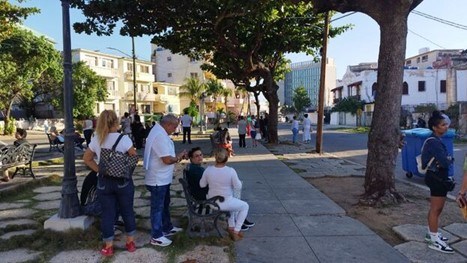The Revived Scene around the US Embassy in Havana

Bag watchers, help with paperwork, photos, and street vendors for hundreds of Cubans waiting in line for visas or interviews.
By Juan Diego Rodríguez (14ymedio)
HAVANA TIMES – There were 20 minutes to go until 9 in the morning, when the U.S. Embassy opens in Havana, and there were already about 200 people lining up this Thursday, a day after the resumption of the delivery of immigrant visas in Havana. That, not counting those who were already inside and the two large rows of cars that stretched along K Street.
In the area, businesses that have been languishing for years due to the lack of activity at the diplomatic headquarters, are rubbing their hands. “It’s been five very hard years,” admits Mileydis, who with her mother runs a small bag storage business near the embassy. “Just when the consular procedures were closed, we had embarked a few months earlier on repairs to improve the premises, and the whole expense was for nothing because everything was paralyzed.”
After that time, “many cafeterias in this area, which survive from the clientele who come to their visa appointments, were closed, and in many cases the owners ended up leaving the country,” laments the 41-year-old woman, who saw her Havana coastal neighborhood languish. “Only people who come for the interview or go to the funeral home [at Calzada and K] come to this part of El Vedado, but without them there are not many customers.”
The crowd, in fact, is alien to the place. Most, even, have expressly arrived in Havana to carry out the procedures. “We are not from here,” they answer when asked about a place to find a coffee.
Street vendors proliferate in the area, although they still lack the life of yesteryear. A woman, in front of the park, sells snacks. Another man who proclaims peanuts aloud is called over from the cars for some food.
Two police officers escort a woman who comes out every now and then with a list in her hand and calls the applicants by name and surname to form a group of between 30 or 40 people. When they are all there, she leads them inside. Many are just waiting to pick up their visa in the afternoon, while others are coming to their appointments for an interview, which the embassy began on December 29.
The faces are younger than usual. The restart of the family reunification program in May last year has rejuvenated those who are now waiting. Many retirees who took advantage of this method to meet with their children who are already established in the United States have already passed their procedures, and now the majority of people are something else. Among the lucky ones of the day, a family with a child left the building smiling, with the papers in their hands, and hugged those who were waiting for them nearby to congratulate them.

Although inside the embassy there is now a bag for certain belongings, Mileydis still experiences joy at being able to resume her task. “It still seems to me a dream that we have been able to reopen the business and also that they are reopening some places that offer coffee, breakfast and snacks,” she says. “This was a desert; even the home restaurant at the corner has had a very bad time, and it has a tremendous view from the terrace and has appeared in a lot of magazines.”
Mileydis has taken over from her mother who is now too old “to stand there holding the wallets of people who come to the embassy,” giving them a number to identify their belongings and placing them on a large shelf in the room on the ground floor. “Now I am at the front of the business, and I hope that in the coming months we will get out of the hole that we are in now.”
The place is just one more in the fragile network where there are also private accommodations for Cubans who travel from the provinces to go to their consular appointments; for the self-employed who devote themselves to filling out, for other people, the mandatory digital forms for consular procedures; and even for the parking attendants who take care of motorcycles and vehicles.
“It’s weird the things you miss; I was even nostalgic for that commotion of people. Luckily they’re back,” Mileydis says with relief.
Many of those who have reached the area around the consulate are also members of various Facebook groups in which Internet users exchange suggestions and recommendations for the consular interview. From how to dress, what are the best places to rent a room for those who come from another province, to tips on how to behave in front of the immigration officer.
Those groups have been in turmoil in recent months, and the mood that runs through many of their members is hope. “Now they are going to step on the accelerator and process all pending cases,” say some optimists, while others calculate when their interview will be from the time elapsed since another, who has already scheduled his consular appointment, presented the documents for the immigrant visa for the first time.
“No low-cut clothes, no eye-catching earrings,” advises one of the moderators of a group of parents applying for a family reunification visa. “Quiet in the line, everything must be well-organized there, not like a line to buy chicken,” says the woman who also recommends “speaking loudly and clearly” through the speaker inserted into the thick glass that separates the applicant from the immigration officer. And above all, “you have to present yourself as someone who is very enthusiastic.”
Translated by Regina Anavy for Translating Cuba
—–





